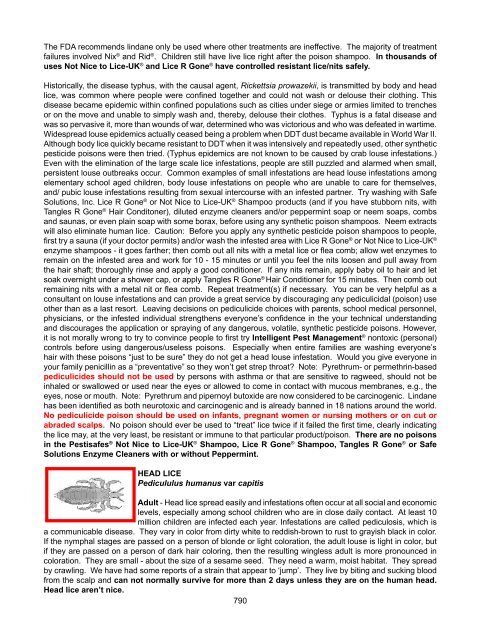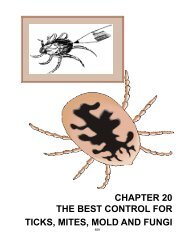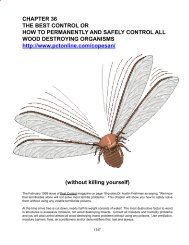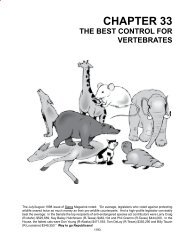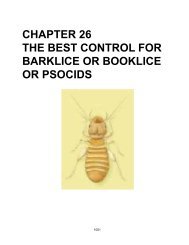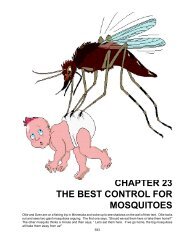chapter 16 the best control for human lice and scabies
chapter 16 the best control for human lice and scabies
chapter 16 the best control for human lice and scabies
You also want an ePaper? Increase the reach of your titles
YUMPU automatically turns print PDFs into web optimized ePapers that Google loves.
The FDA recommends lindane only be used where o<strong>the</strong>r treatments are ineffective. The majority of treatment<br />
failures involved Nix ® <strong>and</strong> Rid ® . Children still have live <strong>lice</strong> right after <strong>the</strong> poison shampoo. In thous<strong>and</strong>s of<br />
uses Not Nice to Lice-UK ® <strong>and</strong> Lice R Gone ® have <strong>control</strong>led resistant <strong>lice</strong>/nits safely.<br />
Historically, <strong>the</strong> disease typhus, with <strong>the</strong> causal agent, Rickettsia prowazekii, is transmitted by body <strong>and</strong> head<br />
<strong>lice</strong>, was common where people were confined toge<strong>the</strong>r <strong>and</strong> could not wash or delouse <strong>the</strong>ir clothing. This<br />
disease became epidemic within confined populations such as cities under siege or armies limited to trenches<br />
or on <strong>the</strong> move <strong>and</strong> unable to simply wash <strong>and</strong>, <strong>the</strong>reby, delouse <strong>the</strong>ir clo<strong>the</strong>s. Typhus is a fatal disease <strong>and</strong><br />
was so pervasive it, more than wounds of war, determined who was victorious <strong>and</strong> who was defeated in wartime.<br />
Widespread louse epidemics actually ceased being a problem when DDT dust became available in World War II.<br />
Although body <strong>lice</strong> quickly became resistant to DDT when it was intensively <strong>and</strong> repeatedly used, o<strong>the</strong>r syn<strong>the</strong>tic<br />
pesticide poisons were <strong>the</strong>n tried. (Typhus epidemics are not known to be caused by crab louse infestations.)<br />
Even with <strong>the</strong> elimination of <strong>the</strong> large scale <strong>lice</strong> infestations, people are still puzzled <strong>and</strong> alarmed when small,<br />
persistent louse outbreaks occur. Common examples of small infestations are head louse infestations among<br />
elementary school aged children, body louse infestations on people who are unable to care <strong>for</strong> <strong>the</strong>mselves,<br />
<strong>and</strong>/ pubic louse infestations resulting from sexual intercourse with an infested partner. Try washing with Safe<br />
Solutions, Inc. Lice R Gone ® or Not Nice to Lice-UK ® Shampoo products (<strong>and</strong> if you have stubborn nits, with<br />
Tangles R Gone ® Hair Conditoner), diluted enzyme cleaners <strong>and</strong>/or peppermint soap or neem soaps, combs<br />
<strong>and</strong> saunas, or even plain soap with some borax, be<strong>for</strong>e using any syn<strong>the</strong>tic poison shampoos. Neem extracts<br />
will also eliminate <strong>human</strong> <strong>lice</strong>. Caution: Be<strong>for</strong>e you apply any syn<strong>the</strong>tic pesticide poison shampoos to people,<br />
first try a sauna (if your doctor permits) <strong>and</strong>/or wash <strong>the</strong> infested area with Lice R Gone ® or Not Nice to Lice-UK ®<br />
enzyme shampoos - it goes far<strong>the</strong>r; <strong>the</strong>n comb out all nits with a metal <strong>lice</strong> or flea comb; allow wet enzymes to<br />
remain on <strong>the</strong> infested area <strong>and</strong> work <strong>for</strong> 10 - 15 minutes or until you feel <strong>the</strong> nits loosen <strong>and</strong> pull away from<br />
<strong>the</strong> hair shaft; thoroughly rinse <strong>and</strong> apply a good conditioner. If any nits remain, apply baby oil to hair <strong>and</strong> let<br />
soak overnight under a shower cap, or apply Tangles R Gone ® Hair Conditioner <strong>for</strong> 15 minutes. Then comb out<br />
remaining nits with a metal nit or flea comb. Repeat treatment(s) if necessary. You can be very helpful as a<br />
consultant on louse infestations <strong>and</strong> can provide a great service by discouraging any pediculicidal (poison) use<br />
o<strong>the</strong>r than as a last resort. Leaving decisions on pediculicide choices with parents, school medical personnel,<br />
physicians, or <strong>the</strong> infested individual streng<strong>the</strong>ns everyone’s confidence in <strong>the</strong> your technical underst<strong>and</strong>ing<br />
<strong>and</strong> discourages <strong>the</strong> application or spraying of any dangerous, volatile, syn<strong>the</strong>tic pesticide poisons. However,<br />
it is not morally wrong to try to convince people to first try Intelligent Pest Management ® nontoxic (personal)<br />
<strong>control</strong>s be<strong>for</strong>e using dangerous/useless poisons. Especially when entire families are washing everyone’s<br />
hair with <strong>the</strong>se poisons “just to be sure” <strong>the</strong>y do not get a head louse infestation. Would you give everyone in<br />
your family penicillin as a “preventative” so <strong>the</strong>y won’t get strep throat? Note: Pyrethrum- or permethrin-based<br />
pediculicides should not be used by persons with asthma or that are sensitive to ragweed, should not be<br />
inhaled or swallowed or used near <strong>the</strong> eyes or allowed to come in contact with mucous membranes, e.g., <strong>the</strong><br />
eyes, nose or mouth. Note: Pyrethrum <strong>and</strong> pipernoyl butoxide are now considered to be carcinogenic. Lindane<br />
has been identified as both neurotoxic <strong>and</strong> carcinogenic <strong>and</strong> is already banned in 18 nations around <strong>the</strong> world.<br />
No pediculicide poison should be used on infants, pregnant women or nursing mo<strong>the</strong>rs or on cut or<br />
abraded scalps. No poison should ever be used to “treat” <strong>lice</strong> twice if it failed <strong>the</strong> first time, clearly indicating<br />
<strong>the</strong> <strong>lice</strong> may, at <strong>the</strong> very least, be resistant or immune to that particular product/poison. There are no poisons<br />
in <strong>the</strong> Pestisafes ® Not Nice to Lice-UK ® Shampoo, Lice R Gone ® Shampoo, Tangles R Gone ® or Safe<br />
Solutions Enzyme Cleaners with or without Peppermint.<br />
HEAD LICE<br />
Pedicululus <strong>human</strong>us var capitis<br />
Adult - Head <strong>lice</strong> spread easily <strong>and</strong> infestations often occur at all social <strong>and</strong> economic<br />
levels, especially among school children who are in close daily contact. At least 10<br />
million children are infected each year. Infestations are called pediculosis, which is<br />
a communicable disease. They vary in color from dirty white to reddish-brown to rust to grayish black in color.<br />
If <strong>the</strong> nymphal stages are passed on a person of blonde or light coloration, <strong>the</strong> adult louse is light in color, but<br />
if <strong>the</strong>y are passed on a person of dark hair coloring, <strong>the</strong>n <strong>the</strong> resulting wingless adult is more pronounced in<br />
coloration. They are small - about <strong>the</strong> size of a sesame seed. They need a warm, moist habitat. They spread<br />
by crawling. We have had some reports of a strain that appear to ‘jump’. They live by biting <strong>and</strong> sucking blood<br />
from <strong>the</strong> scalp <strong>and</strong> can not normally survive <strong>for</strong> more than 2 days unless <strong>the</strong>y are on <strong>the</strong> <strong>human</strong> head.<br />
Head <strong>lice</strong> aren’t nice.<br />
790


